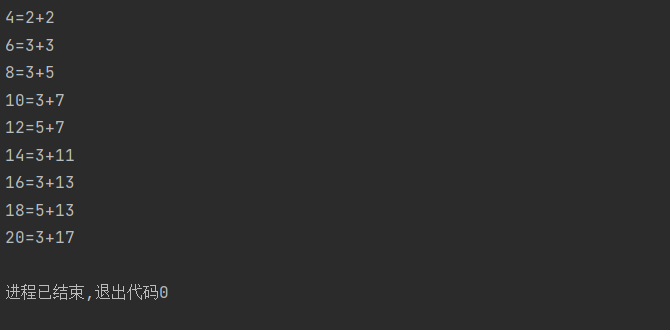实验4 函数与异常处理应用编程
一、实验内容
1.实验任务1
task1.py:
1 print(sum) 2 sum=42 3 print(sum) 4 5 def inc(n): 6 sum=n+1 7 print(sum) 8 return sum 9 10 sum=inc(7)+inc(7) 11 print(sum)
运行截图:

回答:
4处使用的标识符sum不是代表一个变量名。
第一个:内置作用域
第二个:全局作用域
第三个:局部作用域
第四个:全局作用域
2.实验任务2
task2_1.py:
1 def func1(a,b,c,d,e,f): 2 '''返回参数a,b,c,d,e,f构成的列表 3 默认,参数按位置传递;也支持关键字传递 4 ''' 5 return [a,b,c,d,e,f] 6 7 def func2(a,b,c,*,d,e,f): 8 '''返回参数a,b,c,d,e,f构成的列表 9 *后面的参数只能按关键字传递 10 ''' 11 return [a,b,c,d,e,f] 12 13 def func3(a,b,c,/,d,e,f): 14 '''返回参数a,b,c,d,e,f构成的列表 15 /前面的参数只能按位置传递''' 16 return[a,b,c,d,e,f] 17 18 print(func1(1,9,2,0,5,3)) 19 print(func1(a=1,b=9,c=2,d=0,e=5,f=3)) 20 print(func1(1,9,2,f=3,d=0,e=5)) 21 22 print(func2(11,99,22,d=0,e=55,f=33)) 23 print(func2(a=11,b=99,c=22,d=0,e=55,f=33)) 24 print(func2(11,99,22,0,55,33))

说明 func2函数中d,e,f 需要用关键字参数传递。
task2_2.py:
1 list1=[1,9,8,4] 2 3 print(sorted(list1)) 4 print(sorted(list1,reverse=True)) 5 print(sorted(list1,True))
运行截图:

回答:python内置函数sorted()中,参数reverse的传递方式必须使用关键字传递。
task2_3.py:
1 def func(a,b,c,/,*,d,e,f):
2 return ([a,b,c,d,e,f])
3 print(func(1,2,3,d=4,e=5,f=6))
运行截图:

3.实验任务3
task3.py:
1 def solve(a,b,c): 2 '''求解一元二次方程,返回方程的两个根 3 :para:a,b,c:int 方程系数 4 :return:tuple 5 ''' 6 delta=b*b-4*a*c 7 delta_sqrt=abs(delta)**0.5 8 p1=-b/2/a 9 p2=delta_sqrt/2/a 10 if delta>0: 11 root1=p1+p2 12 root2=p1-p2 13 else: 14 root1 = complex(p1, p2) 15 root2 = complex(p1, -p2) 16 return root1,root2 17 print(solve.__doc__) 18 19 while True: 20 try: 21 a,b,c=eval(input('Enter eqution coefficient: ')) 22 if a==0: 23 raise 24 except: 25 print('invalid input, or, a is zero') 26 break 27 else: 28 root1,root2=solve(a,b,c) 29 print(f'root1={root1:.2f},root2={root2:.2f}') 30 print()
运行截图:

4.实验任务4
task4.py:
1 def list_generator(a,b,step=1): 2 n=[] 3 while a<=b: 4 n.append(a) 5 a=a+step 6 return n 7 8 list1=list_generator(-5,5) 9 print(list1) 10 11 list2=list_generator(-5,5,2) 12 print(list2) 13 14 list3=list_generator(1,5,0.5) 15 print(list3)
运行截图:

5.实验任务5
task5.py:
1 def is_prime(x): 2 if x<2: 3 return False 4 for i in range(2,x): 5 if x%i==0: 6 return False 7 return True 8 for j in range(2,21,2): 9 for n in range(1,21): 10 if is_prime(n)==True and is_prime(j-n)==True and n<=j-n: 11 print(f'{j}={n}+{j-n}') 12 break
运行截图:

6.实验任务6
task6.py:
1 def encoder(x): 2 a=[] 3 for i in x: 4 b=ord(i) 5 if 97<=b<=117 or 65<=b<=85: 6 b+=5 7 elif 118<=b<=122 or 86<=b<90: 8 b=b-21 9 a.append(chr(b)) 10 return ''.join(a) 11 def decoder(x): 12 a=[] 13 for i in x: 14 b=ord(i) 15 if 102<=b<=122 or 70<=b<=90: 16 b-=5 17 elif 97<=b<=101 or 65<=b<=69: 18 b=b+21 19 a.append(chr(b)) 20 return ''.join(a) 21 x=input('输入英文文本: ') 22 m=encoder(x) 23 n=decoder(m) 24 print(f'编码后的文本:{m}') 25 print(f'对编码后的文本解码:{n}')
运行截图:


7.实验任务7
task7.py:
1 def collatz(x): 2 if x%2==0: 3 x=x/2 4 return x 5 return 3*x+1 6 try: 7 x=int(input('Enter a positive integer:')) 8 if x<=0 or type(x)!=int: 9 raise NameError and ValueError 10 except NameError and ValueError: 11 print('Error: must be a positive integer') 12 else: 13 a=[x] 14 while(x!=1): 15 x=collatz(x) 16 a.append(x) 17 print(a)
运行截图:





二、实验总结
通过本次实验任务我对ord()与chr()函数更加熟练运用了,也能正确定义和使用函数,但编写的代码比较繁杂,课后应多练习,简化代码。



